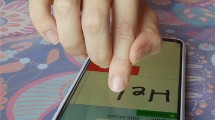Abstract
The evolution of computer front panels and punch tapes and punch cards to teletype interfaces and the keyboards of modern personal computers shows that the problem of a faster man-machine interaction has been a great scientific and technological challenge since the origin of computers. During the last decades many efforts have been made in the technological field to design special peripheral devices such as the graphic tablet, the scanner, the mouse, electronic ink and so on. Furthermore, efforts have also been made to study models of writing generation motor and recognition algorithms. But in spite of technological and architectural progress made in the field of computers, the problem of a friendly interaction between man and computer at least at the same friendly level that exists with a sheet of paper and a pencil, still remains unresolved.
Access this chapter
Tax calculation will be finalised at checkout
Purchases are for personal use only
Preview
Unable to display preview. Download preview PDF.
Similar content being viewed by others
References
S. Impedovo, L. Ottaviano, S. Occhinegro, Optical Character Recognition — A Survey, International Journal of Pattern Recognition and Artificial Intelligence 5(1,2), 1–24 (1991).
R.G. Casey, H. Takahashi, Experience in segmenting and classifying the NIST data base, in [35].
V. Govindaraju, S.N. Srihari, Separating handwritten text from interfering stroke, in [35].
H. Nishida, T. Suzuki, S. Mori, Thin line representation from contour representation of handprinted characters, in [35].
P. Morasso, A. Pareto, S. Pagliano, Neural models for handwriting recognition, in [35].
L.R.B. Schomaker, H.-L. Teulings, Stroke-versus character-based recognition of on-line, connected cursive script, in [35].
H.-L Teulings, L.R.B. Schomaker, Unsupervised learning of prototype allographs in cursive script recognition, in [35].
Y.-J. Liu, J.-W. Tai, An on-line Chinese character recognition system for handwritten in Chinese calligraphy, in [35].
J.-W. Tai, Y.-J. Liu, L.-Q. Zhang, A new approach for feature extraction and feature selection of handwritten Chinese character recognition, in [35].
S.L. Shiau, S J. Kung, A.J. Hsieh, J.W. Chen, M.C.Kao, Stroke-order free on-line Chinese character recognition by structural decomposition method, in [35].
R. Fenrich, Segmentation of automatically located handwritten numeric strings, in [35].
M.J.J. Holt, M.M. Beglou, S. Datta, Slant-independent letter segmentation for off-line cursive script recognition, in [35].
J.J. Hull, T.K. Ho, J. Favata, V. Govindaraju, S.N. Srihari, Combination of segmentation-based and wholistic handwritten word recognition algorithms, in [35].
T. Fujisaki, H.S.M. Beigi, C.C. Tappert, M. Ukelson, C.G. Wolf, Online recognition of unconstrained handprinting: a stroke based system and its evaluation, in [35].
C.A. Higgins, D.M. Ford, A new segmentation method for cursive script recognition, in [35].
K. Sakai, H. Asami, Y. Tanabe, Advanced Application Systems for handwritten Character Recognition, in [35].
K. Yamamoto, H. Yamada, T. Saito, Current state of recognition method for Japanese characters and database for research of handprinted character recognition, in [35].
A.C. Downton, R.W.S. Tregidgo, C.G. Leedham, Hendrawan, Recognition of handwritten British postal addresses, in [35].
P.S.P. Wang, M.V. Nagendraprasad, A.Gupta, A neural net based ‘hybrid’ approach to handwritten numeral recognition, in [35].
F. Chiavetta, V. Di Gesù, G. Dimauro, G. Gerardi, S. Impedovo, G. Pirlo, D. Tegolo, A Transputer-based system for multi-stroke character recognition, in [35].
J.V. Moreau, A new system for automatic reading of postal checks, in [35].
Y. Nakano, Advanced application — systems for handwritten character recognition, in [35].
K. Seino, Y. Tanabe, K. Sakai, A linguistic post processing based on word occurrence probability, in [35].
G. Dimauro, S. Impedovo, G. Pirlo, Uncertainty in the recognition process: some considerations on human variable behaviour, in [35].
C.Y. Suen, J. Guo, Z.C. Li, Computer and human recognition of handprinted characters by parts, in [35].
J.C. Simon, O.Baret, Cursive words recognition, in [35].
J. Camillerapp, G. Lorette, G. Menier, H. Oulhadj, J.C. Pettier, Off-line and on-line methods for cursive handwriting recognition, in [35].
A. Zahour, B. Taconet, A. Faure, Machine recognition of arabic cursive writing, in [35].
B. Taconet, A. Zahour, A. Faure, A new global off-line recognition method for handwritten words, in [35].
I.J. Evett, C.J. Wells, F.G. Keenan, T. Rose, R J. Whitrow, Using linguistic information to aid handwriting recognition, in “From Pixels to Features III”, S.Impedovo and J.C.Simon eds., Elsevier 1992.
I. Yoshimura, M. Yoshimura, On line signature verification incorporating the direction of pen movement — An experimental examination of the effectiveness, in [35].
R. Plamondon, P. Yergeau, J.J. Brault, A multi-level signature verification system, in [35].
G. Dimauro, S. Impedovo, G. Pirlo, A stroke-oriented approach to signature verification, in [35].
P. Brittan, M.C. Fairhurst, An approach to handwritten signature verification using a high performance parallel architecture, in [35].
S. Impedovo, J.C. Simon (eds.): From Pixels to Features III — Frontiers in Handwriting Recognition Elsevier 1992.
Author information
Authors and Affiliations
Editor information
Editors and Affiliations
Rights and permissions
Copyright information
© 1994 Springer-Verlag Berlin Heidelberg
About this paper
Cite this paper
Impedovo, S. (1994). Frontiers in Handwriting Recognition. In: Impedovo, S. (eds) Fundamentals in Handwriting Recognition. NATO ASI Series, vol 124. Springer, Berlin, Heidelberg. https://doi.org/10.1007/978-3-642-78646-4_2
Download citation
DOI: https://doi.org/10.1007/978-3-642-78646-4_2
Publisher Name: Springer, Berlin, Heidelberg
Print ISBN: 978-3-642-78648-8
Online ISBN: 978-3-642-78646-4
eBook Packages: Springer Book Archive




